
Help on the Go - Dallas Airmotive Rotorcraft Engine Away Team

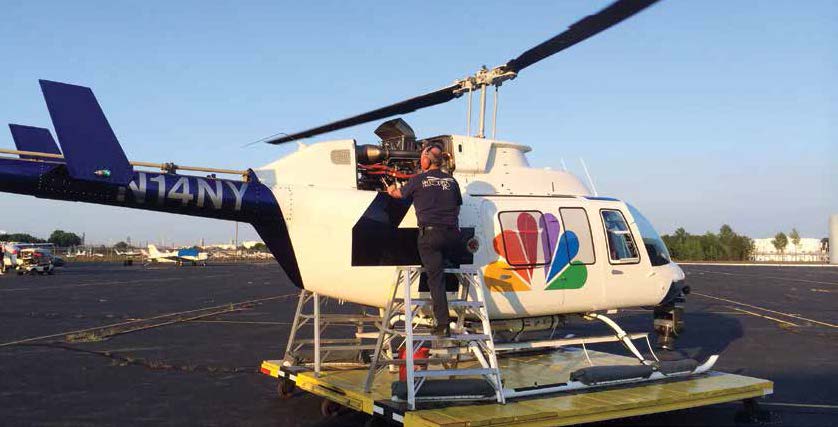
An inscription on the James Farley Post Office in New York City reads: “Neither snow nor rain nor heat nor gloom of night stays these couriers from the swift completion of their appointed rounds.”
This is the fabled motto of the United States Postal Service (USPS). Much in the same breath, and with the same passion, the team that we employ to do work away from the shop keeps our operator base in the air and flying trouble free.
Our industry uses the monikers “away team,” “rapid response,” or “on-site support” to name a few. At Dallas Airmotive, we call our team, “F1RST SUPPORT.” It can happen in a hangar in the morning, on a runway at night or in the middle of a farmer’s field at any hour of the day. Break downs happen in the most inconvenient places and at the least opportune times. Our engine away team thrives on this type of challenge. The urgency of the situation is what makes them tick. We pride ourselves on the ability to dispatch the team within a few hours of the call coming in. The individuals who make up this team pride themselves on placing the operator’s situation as their top priority. Whether domestic or international, we strive to provide the same level of service.
Troubleshooting
A call came in one morning from an operator of a Bell 206B3. His engine ToT was running higher than he expected it to be so he set the helicopter down in a field well away from the airport. Our technician helped troubleshoot the problem over the phone and determined that on-site service was necessary. After arriving at the remote location which was surrounded by tall grass and brush, the real work began.
ToT was far higher than normal and the compressor was determined to be damaged. A lease compressor was ordered right away and dispatched on the next flight out. It took a four-hour round trip to the nearest airport to retrieve the compressor. Early the next morning the technician was back on site using the field service truck to support his engine work. The compressor was changed and the aircraft flew away well before lunch. A 24-hour turn-around was accomplished and the damaged compressor was shipped to the shop for repair.
While many projects require on-site support, they all begin with a phone call. We received a call from an MD500 operator who was struggling with low power. After discussing the situation and going through some Q&A and diagnostics on the phone, our technician asked them to check the pressure line from the engine to the torque gauge to see if a leak could be detected. There was a leak and we were able to address it over the phone. Disaster averted, customer pleased, and schedule maintained — a definite recipe for success.
Although engines are our specialty, our technicians become so familiar with the workings of helicopters that we are often able to provide troubleshooting assistance to include issues that are outside the engine but might ultimately affect its performance. Most calls that come in to us are believed by the operator to be engine related. We received a call from a Bell 206L4 operator with a Roll-Royce M250 C30P engine. They had landed in a remote location because of a high-pitched whining noise that they believed was coming from the engine. Upon arrival at the location, we determined that it was not engine related, but rather that the noise was coming from the main transmission hydraulic pump. This was an easy fix in the field and resulted in very minimal downtime.
Another call for help presented itself when an MD500 operator called with high ToT. Our technician was able to troubleshoot over the phone and make a diagnosis. We reached out to a one of our regional shops to deliver the parts down to the job site to coincide with the arrival of our technician. His diagnosis was true and the bleed air heater line that was delivered fixed the problem in short order. Our network helped us out and the operator flew away with ToT back in normal range.
The call for service might come in to the shop, to the REM or directly to the field service technician. These groups communicate to each other in order to address the issue appropriately. The level of maintenance that can occur in the field varies greatly. The decision as to what material and tooling needs to be taken to the job site is determined by the reported issue, our experience with that issue, our physical proximity to the site, and the urgency of the necessary action.

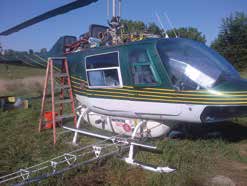
For instance, an oil leak likely necessitates less action than an inspection for metal in the oil. A standard engine removal and reinstallation is usually a straightforward occurrence, whereas the troubleshooting and replacement of a smoking turbine module has more opportunity to present challenges. When we recognize that there are a number of unknowns in an event, the team works to have assets available on site or ready for immediate dispatch. Ultimately, the situation that we find during the troubleshooting phase might not be a candidate for repair in the field. Having options available to mitigate downtime and prevent an AOG is the ultimate goal when we have to induct the project into the shop for repair or overhaul.
At times we face what appears to be a straightforward project as reported by the operator; however, some of these projects can take a different twist. We reported for service to Selma, AL, to change a burnt first-stage nozzle on a Rolls-Royce M250 C20B. Upon review of the situation, the anti-ice valve seat had come loose and gone downstream through the turbine, creating FOD and the necessary removal of the turbine. A lease turbine was ordered, delivered and installed and the operator flew away safely and happily. He did not realize the danger he was flying in until we diagnosed the “burnt first-stage nozzle” as heavy FOD.
Anatomy of a Team
The individuals who make up a successful away team have some unique characteristics in that they have to have a mastery of the engine base on which they work. They have to be adaptable to changing conditions, be it weather related, time constraints, long hours, short staff or logistical challenges. They must be prepared to address difficult challenges both technically and in customer contact. Being able to diffuse a situation with an operator to let them know that they are in good hands and are on the way to having the situation handled is a key element to the makeup of our team.
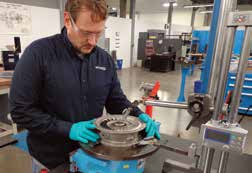


In order to to gain the confidence of the customer, providing maintenance options, rental availability, quick turn-around in the shop and a host of other offerings is something that must be assessed as soon as possible. Our team members have a passion for service that transcends their personal lives. Many times they have changed their vacation plans, cancelled a personal activity or altered where they were travelling to in order to satisfy a customer. A great portion of our success as a company is due to these efforts.
Making It Work
As a mobile extension of our repair station, we face the challenge of maintaining continuity with our team who, due to their busy remote schedules, do not make it into the shop regularly. Maintaining their stock of material and consumables, repairing and calibrating tools, updating maintenance and training documentation, and coordinating customer needs and events are all part of the cooperation that makes or breaks a team.
All of these activities must happen on a daily basis while remaining invisible and seamless to the helicopter operator. Electronic communication makes this process easier. We can address most any need at any time through e-mail, texting, mobile messaging and cellular service. Logistic needs can be communicated. Parts can be requested, ordered and dispatched quickly. Technical data can be procured and displayed. While all of this is happening, the next flight can be booked and the next event scheduled as the need arises.
The Support Structure
Our domestic service network consists of regional turbine shops strategically located throughout the country in support of our larger overhaul center. The overhaul shop provides component repair, all levels of module repair, accessory, and engine and module exchange, and full testing services. The various shops contain a full range of customer service, engineering, logistics and support staff. Additionally, we have regional engine managers (REMs) who are positioned throughout the country to facilitate front-line contact with operators to discuss our service offerings and identify the unique needs of each team. The service network, REMs and the field service team stay in close contact with each other.
Some projects grow in magnitude and become more than a single member of our team can handle. Occasionally, the demand for service outruns our ability to cover every base. In times like this, we rely on the breadth of our network to pull additional resources into the field that don’t reside with the field service group on a daily basis. The ability to expand our service offering to cover these additional bases is key to customer satisfaction and service. Whether it is an extra hand needed on a project or a number of projects that causes us to flex more of our collective service muscle, we have it covered.
Field Service
We exceed 100 field service events in an average year. This number would most likely be addressed by a single technician if we could coordinate the breakdowns and unscheduled events to coincide with our availability. Alas, the ability to level load these events in the field is not within our grasp so we employ a team of technicians. Many calls come in on nights, weekends and holidays. As long as helicopters fly, the skill set of flexibility, adaptability, ingenuity and innovation are necessary to make sure we are where the action is when we are needed. We encourage the call at any time, welcome the challenge that the work provides and revel in the successful service we can provide to our customers. It takes a team effort to meet the challenges that we face at odd hours, in challenging environments, and in different cultures for the sake of our customers.
We received word from an air medical operator that they needed a gearbox change in the field. Upon arrival, it was determined that the gearbox was not the problem. However, the rotor brake disk was significantly too far forward and was creating problems with the freewheeling unit. The bearing was not pressed down far enough to allow proper operation. This was readily corrected and the mission was able to be completed without further delays.

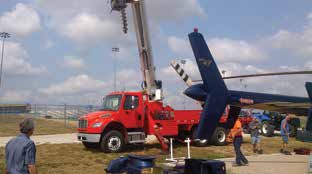
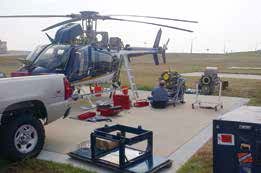
A field service project consists of many of the same elements regardless of the extent of the event. Whether a module is removed and replaced, an engine is changed, a fuel leak is fixed, a rigging issue is adjusted or a service bulletin is completed, the technician provides the service needed and then signs the work off under our repair station in the appropriate section of the log book. This is all tied together in the work package for future maintenance reference and invoicing.
As a Rolls-Royce authorized maintenance repair and overhaul center (AMROC), we focus specifically on the M250 and RR300 models with our service team. In order to provide a greater level of service to the rotorcraft industry, we recently received two new authorizations from Pratt & Whitney Canada. These authorizations as a designated overhaul facility (DOF) are for the PW200 and PW210 models. These new DOF appointments will bring the same level of service in the shop and in the field to the PW200 and PW210 operators that our customers currently receive on the Rolls-Royce products. As a result of these two OEM authorizations, the company has made a decision to focus our efforts on providing industry leading service in a new rotorcraft center of excellence based in the Dallas-Ft.Worth Metroplex area. This state-of-the-art facility is currently under construction and will bring increased capacity, in-shop service, field service and test opportunities to the rotorcraft world on both engine platforms.
The work that we do is based on strong relationships. When our field service technician is working with the operator, owner, pilot or maintenance manager towards the common goal of getting the helicopter back in the air, a bond is formed. Many of our customers ask for their favorite technician by name.
The services we provide encompass the entire rotorcraft industry. From air medical transport to agricultural spray operators, or from the weekend helicopter enthusiast to electronic news gathering, off-shore transport, pipeline or utility monitoring, law enforcement, military applications or tourism, all of these operators have a need to be in the air. We want our customers to recognize that we are the experts in helicopter engine maintenance, and that they can rely on us to provide the right service at the right price at the right time. Flying and managing their business is their primary concern. Their maintenance needs in the shop and in the field can be left to us.
 Jason has been with Dallas Airmotive for the past 17 years. His career started in customer service and has progressed to program and operations management, leading up to his current position as General Manager and Program Director. Jason has experience with a variety of turbine engines including the Honeywell TFE731, GE M601, GE J85/CJ610/CF700, and the Rolls-Royce M250 and Rolls-Royce RR300 and Pratt & Whitney PW200 engine family. Jason says that “Dallas Airmotive is a piece of what I am and it is a joy to come to work each day to provide service to our customers.”
Jason has been with Dallas Airmotive for the past 17 years. His career started in customer service and has progressed to program and operations management, leading up to his current position as General Manager and Program Director. Jason has experience with a variety of turbine engines including the Honeywell TFE731, GE M601, GE J85/CJ610/CF700, and the Rolls-Royce M250 and Rolls-Royce RR300 and Pratt & Whitney PW200 engine family. Jason says that “Dallas Airmotive is a piece of what I am and it is a joy to come to work each day to provide service to our customers.”
